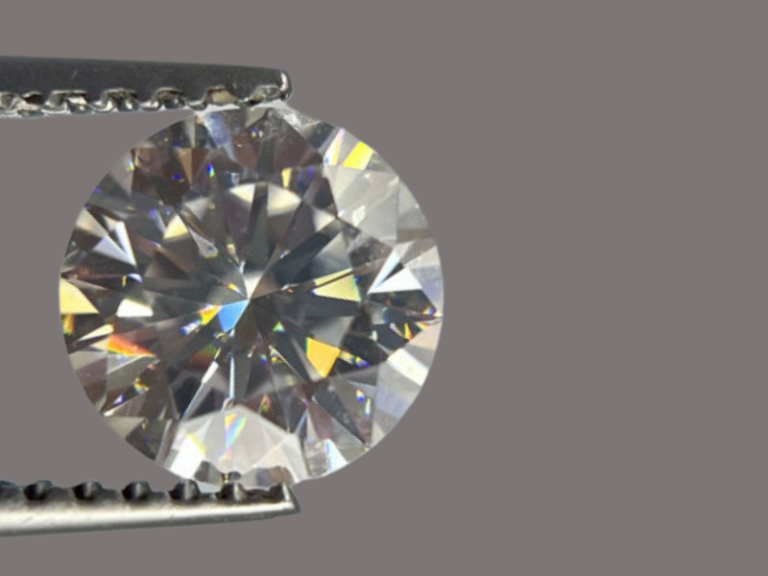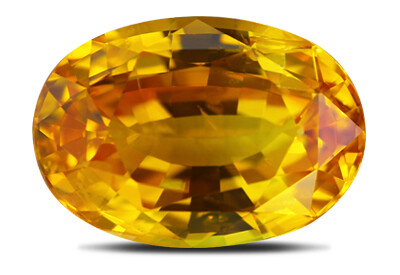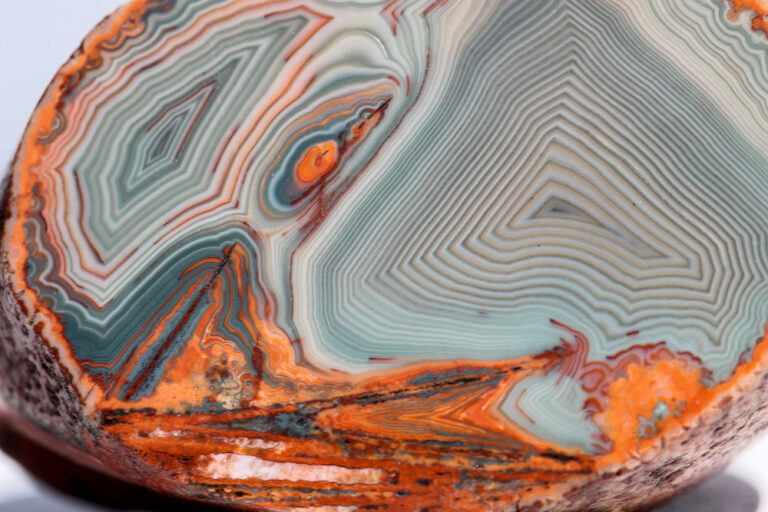Ammolite Stone: Properties, Benefits & Meanings

Ammolite Stone Overview
Ammolite stone is an opal-like organic gemstone found primarily along the eastern slopes of the Rocky Mountains. It is made from fossilized shells, mostly aragonite, with a microstructure inherited from their ammonite ancestors.
Ammolite can contain a variety of minerals besides aragonite, including calcite, silica, and pyrite.
It is one of only a few biogenic gemstones, the others being amber and pearl. It is a rare gemstone known for its shimmering, multicolored iridescence. It’s been said to hold the energies and vibrations of the universe.
This article will detail the properties, meanings, and uses of the Ammolite stone.
What are the origins of The Ammolite Stone?
Ammolite is one of only a few biogenic gemstones, the others being amber and pearl. It is a rare gemstone known for its shimmering, multicolored iridescence. It’s been said to hold the energies and vibrations of the universe. One of the rarest jewels in the world, ammolite is solely mined for commercial purposes in Southern Alberta. The value of ammolite has increased over time due to the material’s rapidly declining supply.
Ammolite is formed from fossilized shells of the Upper Cretaceous disk-shaped ammonites; Placenticeras meeki and Placenticeras intercalare, and (less commonly) cylindrical baculites such as Baculites compressus.
Ammonites were mollusks that flourished in the seas during the Mesozoic era. In addition to coexisting with dinosaurs, they also became extinct at the end of this period.
As the ammonites died, they sank to the bottom and were covered by layers of bentonitic mud and sediment that eventually became shale. Many gem-quality ammonites are found within these concretions—their aragonite shells preserved from conversion into calcite due to the presence of siderite.
History Facts about Ammolite Stones
In 1981, the World Jewellery Confederation (CIBJO) officially designated Ammolite as a gemstone. That exact year commercial mining of Ammolite began, and in 2007 it was declared the official gem of Lethbridge, Alberta—its discovery location.
In 1967, Marcel Charbonneau and Mike Berisoff became the first people to create commercial doublets of Ammolite. They later formed Ammolite Minerals Limited.
Where does the name Ammolite come from?
The name “Ammolite” comes from the spiral shape of their fossilized shells, which resemble tightly coiled rams’ horns.
Pliny the Elder (d. 79 AD near Pompeii, Italy) called fossils of these animals ammonis cornua (“horns of Ammon”) because the Egyptian god Amun—who was typically depicted wearing rams’ horns—was also known by this name in some ancient cultures.
What are some other names for Ammolite?
The fossilized ammonite remains were named snakestones in England because they resemble coiled snakes turned to stone.
Some other names for the gem are:
- aapoak (Kainah for “small, crawling stone”)
- Calcentine
- Korite (given by the Alberta-based mining company Korite)
How to pronounce Ammolite?
Ammolite is pronounced as “am-muh-ligh-t” with stress on the second syllable.
How are Ammolites Stones extracted?
Commercial extraction of gemstones involves digging shallow pits and screening the excavated material for gems. The cavities are carefully examined by hand, and the commercial production is supplemented by individuals who sell their surface-picked findings to Korite International and other producers.
Approximately 50% of the Ammolite stones mined are suitable for jewelry. However, Korite International, which mines most of the world’s supply, produces over 90% of it.
Most ammolite stones do not have enough thickness to be used on their own, so they are given some backing that should not exceed more than 1.5mm in thickness. This is done so that gem cutters can use the gemstone properly. The backing is typically made from shale or synthetic spinel.
If they are given a more stable backing, they will be kept in a free-form shape.
Where can you find The Ammolite Stone?
The Ammolite gemstone, made from the fossilized shells of ammonites, has only been found in significant deposits within the Bearpaw Formation that extends from Alberta to Saskatchewan in Canada and south to Montana in the United States of America.
However, small deposits have been found in a few countries, including:

What are the Physical Properties of Ammolite Stone?
The physical properties of Ammolite stones are:
| Variety | Fossil |
| Chemical Composition | Aragonite |
| Color | Red-Green, Mosaic-Like |
| Hardness (Mohs scale) | 4 |
| Refractive Index | 1.520 – 1.670 |
| Birefringence | 0.150 |
| Specific Gravity | 2.75 – 2.80 |
What is the typical appearance of An Ammolite Stone?
It is common for fine specimens to show an iridescent opal-like play of color; all the spectral colors are possible, though green and red shades predominate.
The microstructure of its aragonite causes the colors in Ammolite stones: unlike most other gems, which get their colors from light absorption, Iridescent coloration is produced when thin platelets that makeup Aragonite stack to create interference; this process occurs only with Ammolite stones.
Thicker layers produce a more significant number of red and green hues; thinner ones create more blues and violets. Reds are the most common colors, owing to the fragility of thinner layers that give rise to blue pigments. When first mined, the colors in raw fossils are not especially dramatic; it takes polishing and possibly other treatments to reveal their full potential.
The Ammolite stone is rarely found in nature without its shale or clay host matrix, which can range from gray to brown. As a result, frost shattering—wherein the delicate ammolite cracks and splits due to exposure and pressure by sedimentary deposits on top of it—is common.
The cracks give it a tessellated appearance, sometimes called “dragon skin” or “stained glass window.” It may be smooth or rippled if mined from deeper deposits.
Sometimes, a complete ammonite shell is recovered with its structure well-preserved: fine and convoluted lines delineate the outer portions of the chambers; overall, the ammonite shell has a shape similar to that of a nautilus.
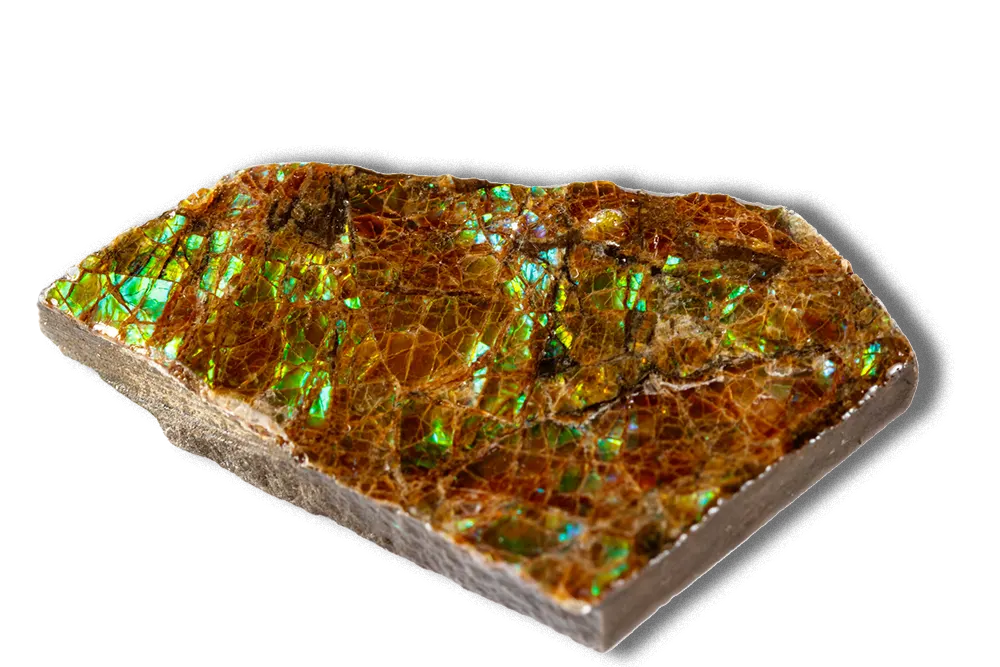
Ammolite Stone Cost and Value
Ammolite’s cost is influenced by several factors, including clarity, carat weight, and cut. Jewelry made from this stone can range from $50 to $500. The cost of a real ammonite fossil can be very high, with some pieces costing as much as $10. A large Ammolite with beautiful iridescence may go for up to $50,000. The factors affecting the cost of Ammolite are:
Some other factors influencing the cost are iridescence and chromatic shift.
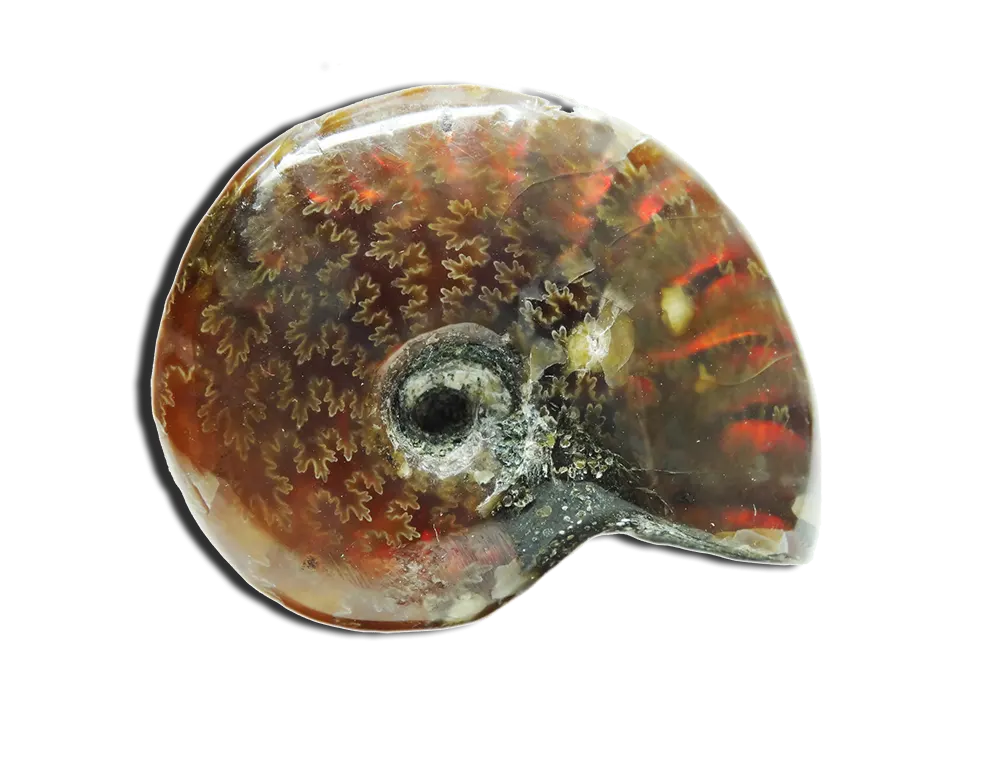
What Materials are used To Imitate Ammolite Stones?
Ammolite is not easily imitated; however, some materials have a passing resemblance that may trick the unsuspecting buyer. These include:
- Labradorite (also known as spectrolite), an iridescent feldspar that may also be of Canadian origin; and broad-flash black opal. Neither are convincing substitutes, and the latter is actually of more excellent value than Ammolite.
- Solcum Stone is a common glass-based imitation of opal. A Slocum stone’s body is transparent to translucent from certain angles, whereas Ammolite is entirely opaque.
- Shell-based marbles, this group includes Lumachella or “fire marble,” a similarly iridescent marble composed of fossilized clam and snail shells. The iridescence of Lumachella is fragmentary and not nearly as brilliant as that of Ammolite.
- The iridescent body of the Abalone (or paua; genus Haliotis) is one last possible imitation. The luster of the abalone shell is silky rather than the near vitreous sheen of polished Ammolite, and their colors do not match closely. However, some abalone shell has been dyed and given a transparent cap of synthetic quartz—in the same fashion as Ammolite. These doublets are perhaps the most deceptive; they’ve also been used to imitate opal.
Ammolite Stone Chakra Connection
Ammolite is a symbol of the Sacral Chakra, located in the lower abdomen. It’s also known as the “sex” or “pleasure” chakra and is associated with pleasure, sexuality, and creativity. In addition, Ammolite is said to have a calming effect on this Chakra, which can help us eliminate anxiety and stress.
What’s another name for Sacral Chakra?
Sacral Chakra is also known as the “Svadhishthana.” It is the second chakra of the body.
Ammolite Stone Uses
Ammolite has the following uses:
- Ammolite pendants will bring protection and prosperity to your relationship. It will help you see the best in your partner and focus on that relationship’s positive qualities. It is a stone of unconditional love, acceptance, and forgiveness.
- Ammolite will help you to release old wounds, resentments, regrets, and other emotional baggage from past relationships. It can also assist with letting go of the pain associated with a breakup or divorce while helping you accept whatever changes are occurring in your life.
- The Ammolite gem is a stone of strength and courage. It will help you to feel more secure about your life path and give you the confidence to move forward despite any fears or concerns that may be holding you back. Ammolite can assist with making decisions, especially those that involve risk-taking. It will also inspire creativity and free thinking while increasing your ability to manifest what is important to you into reality.
- Ammolite jewelry is believed to be helpful during childbirth, both for the mother and her baby. It is also thought to have a calming effect on children and assist them in managing their emotions.
- Ammolite is a very protective stone and can be used for grounding during meditation. It has been used to protect negative energies, especially those surrounding the home.
- Ammolite brooches are said to help you balance your emotions and manage stress. This stone can also be used as an aid for meditation, as it promotes a calming effect on the mind while increasing focus and concentration. Ammolite is often used in crystal healing sessions where emotional issues are addressed.
- Ammolite earrings are also used to ease loneliness, particularly in those who have lost a loved one. Ammolite can be used as an aid for meditation and can help you balance your emotions and manage stress. It has been used to protect against the negative energies surrounding the home, especially those caused by electromagnetic fields (EMFs).
- Ammolite is a beautiful stone used for jewelry, such as a necklace, or ornamental purposes.
- It is also a healing stone and can be placed on the body to benefit different parts. Ammolite is associated with the Heart Chakra, which means that it helps us connect with our emotions and feelings. It allows us to express ourselves more quickly, especially when feeling frustrated or angry.
What does The Ammolite Stone Symbolize?
The Ammolite stone symbolizes the following:
- The Past and the Future: The Ammolite’s spiral shell symbolizes how time moves in cycles. It’s also a reminder that we should embrace the past and look toward the future without forgetting either.
- Past Lives and Karma: The spiral-shaped shells of Ammolites are also a symbol of reincarnation. They tell us that we have lived many lives before this one and will continue to do so after it’s over.
- The connection between Heaven and Earth: Ammolites are also a symbol of our relationship to the earth and how we should ensure that we’re not only aware of its beauty but also take care of it. It’s a reminder that we need to consider how our actions affect the planet.
- Protection from Negative Energies: Ammolites are a powerful symbol of protection. They tell us that we can use them to keep negative energies away so that we can focus on the things that matter most.

How to clean Ammolite Stone Jewelry?
The usual household cleaning method includes the following steps:
- Soak in lukewarm soapy water for 15 – 30 minutes until the dirt and stains loosen up.
- Please remove any remaining residues with a soft toothbrush until it appears spotless.
- Use a gentle dishwasher detergent or baby shampoo solution in case the stains do not come off. You can also use baking soda as an alternative to dishwasher detergent.
- Wipe the fossil with a microfiber cloth until it is smooth and lustrous.
- Cleanse it using burning sage to remove any negativity absorbed, which can negatively impact the surroundings.
- Recharge it using the moon’s light or burying it underground, whichever method suits you.
Be sure to cleanse the Ammolite before you use it. It will help you stay energized and keep negative energies at bay.
Ammolite should be protected from household chemicals and extreme heat exposure, which may cause damage or alterations in coloration. Most ultrasonic cleaners and steamers are safe to use, but it’s recommended that you do so with caution.
FAQ
What other gems can be paired with Ammolite?
You can match Ammolite with other rare or unusual gems like Amber, Alexandrite, or Red Beryl.
If you’re looking for more straightforward pairings, consider choosing the following stones: Turquoise, Blue Topaz, and Aquamarine.
How can Ammolite be charged?
Ammolite can be charged by placing it in the sun or moonlight. You can also set it near a salt lamp or Feng Shui water fountain.
Is Ammolite associated with any health risks?
No information on health risks for this material is currently known. However, it would be best if you always carefully treat mineral specimens. Ammolite is neither poisonous nor radioactive.


